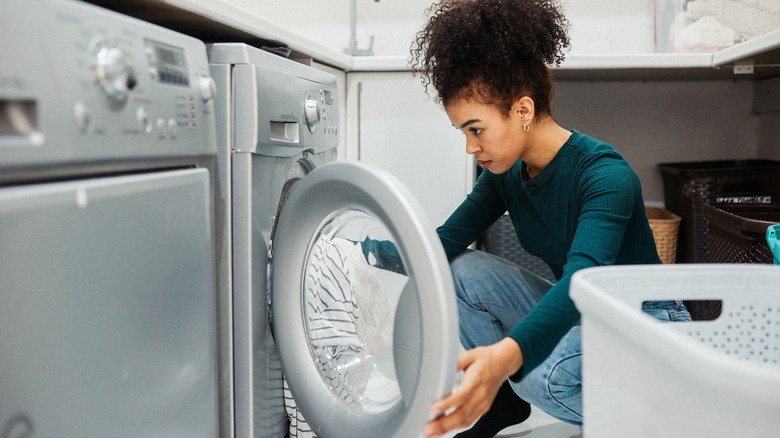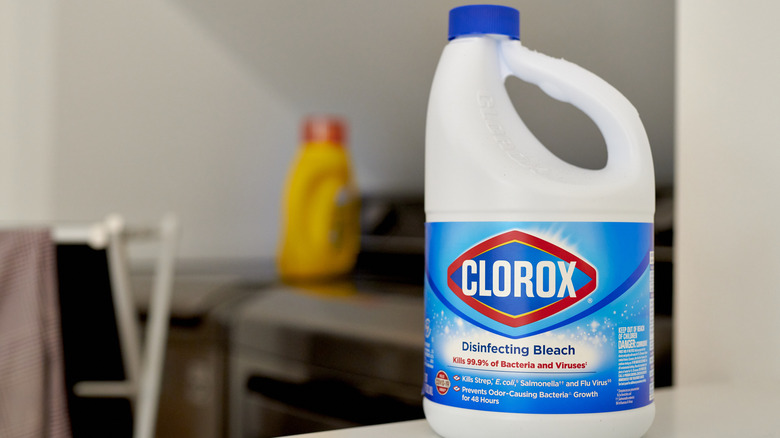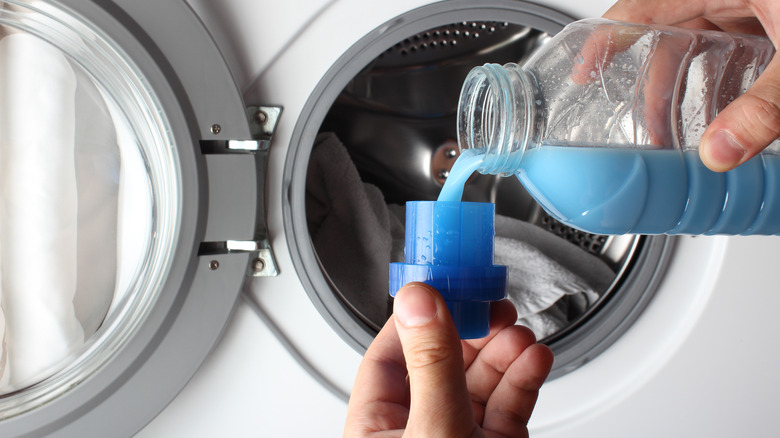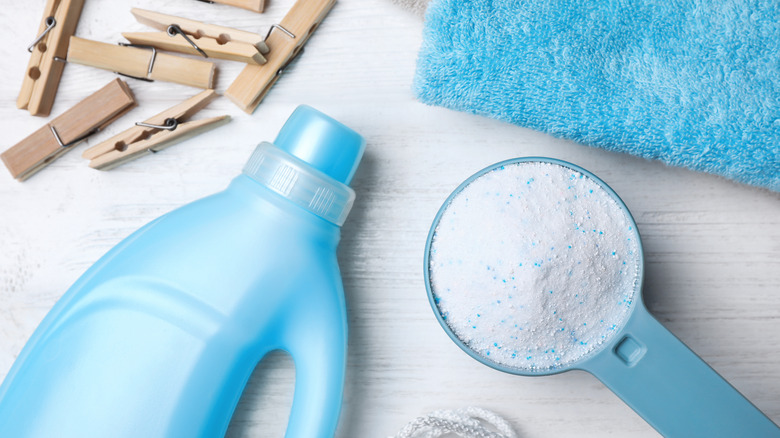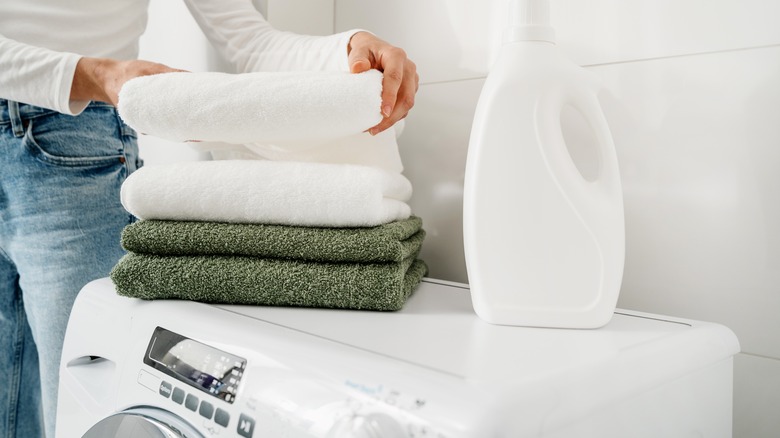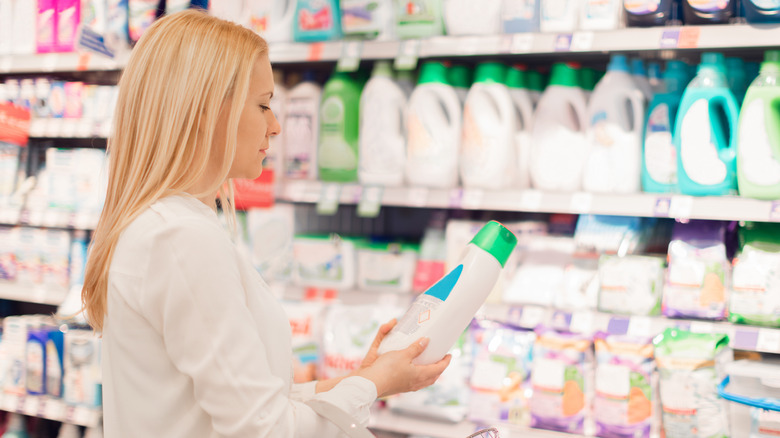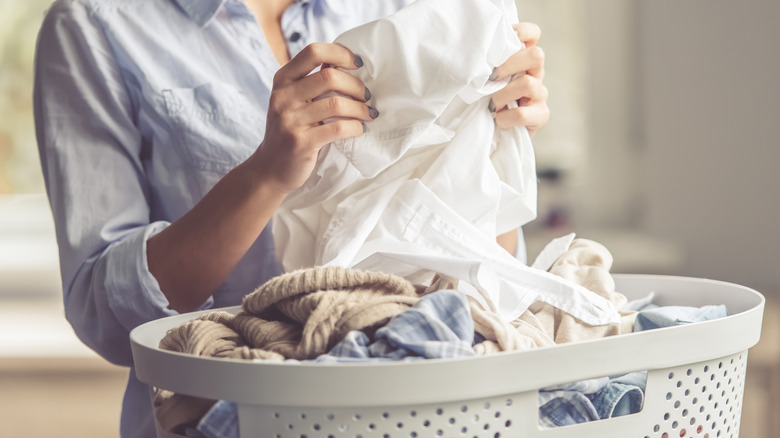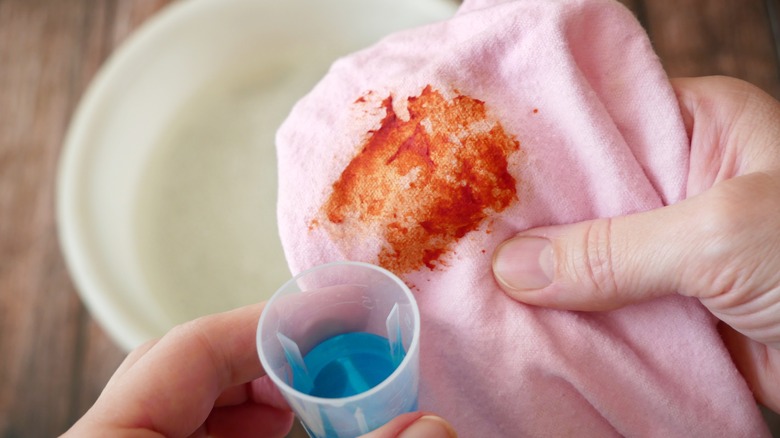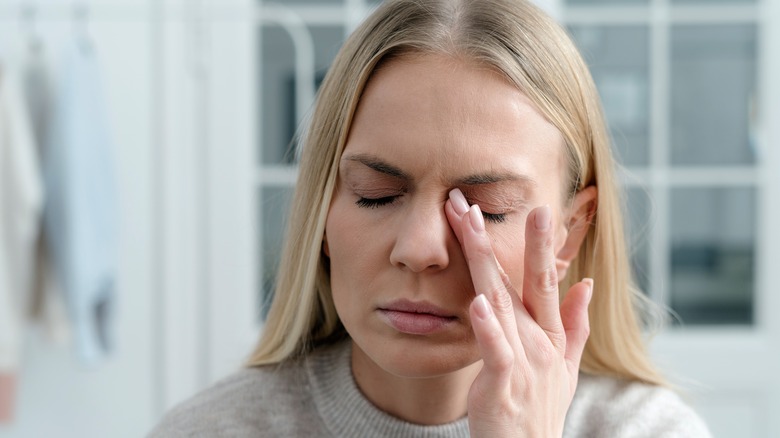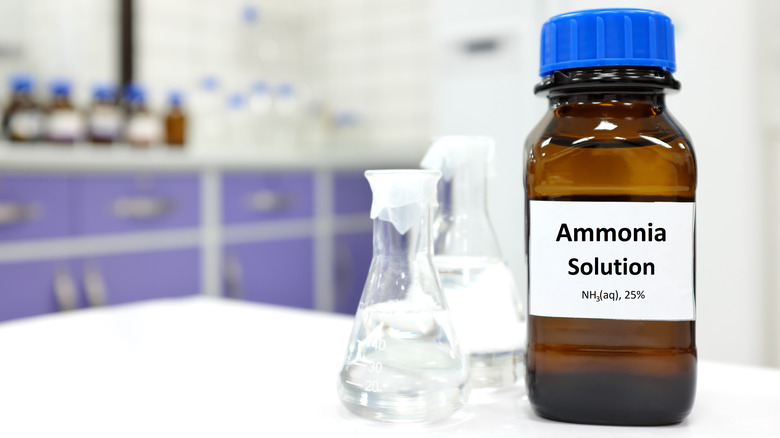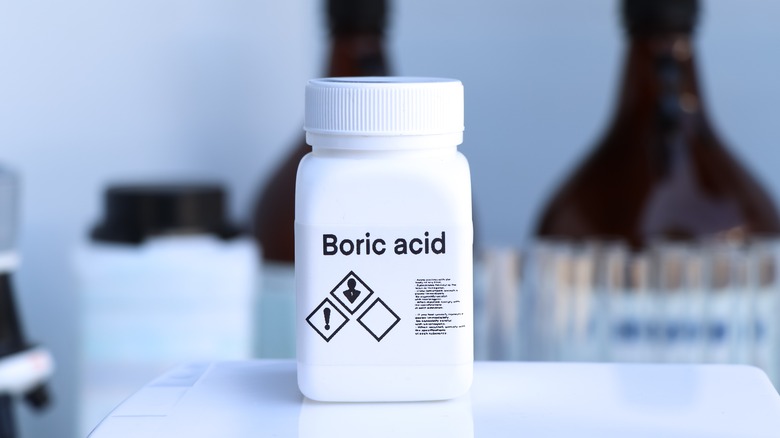Toxic Laundry Room Staples To Avoid Using At All Costs
Laundry day is a routine part of managing your household; many people view this chore as very straightforward. But, under the surface, there is a very complex interaction between fabrics and chemicals, and there are possible environmental and health consequences. While the goal is to clean your clothing, you may expose yourself to toxic ingredients hidden in your brighteners, fabric softeners, or laundry detergents. These chemicals range from synthetic fragrances to bleach, and they can cause skin irritation and respiratory problems. They may pose long-term health risks if you use them repeatedly. Also, these toxic ingredients contribute to environmental pollution and issues in the water's ecosystem.
Phosphates in some laundry detergents are a huge cause of algae blooms that can suffocate aquatic life. Also, synthetic fragrances can trigger an allergy or asthma flareup in some people, due to polluting your indoor air. So, knowing what these toxic ingredients are, where to look for them, and what to use instead helps keep your home a healthier space while you do your part to protect the planet.
Chlorine bleach fumes can be dangerous
Bleach is a laundry room staple in many households due to its ability to disinfect and whiten your clothing. Chlorine bleach is a chemical you'll see in several commercial bleach products, and it has a history of killing viruses and bacteria, and removing stubborn stains from fabric. However, how aggressively it works comes with drawbacks. According to research published in 2017 in the Journal of Thoracic Disease, exposure to chlorine bleach can cause acute respiratory distress syndrome and chemical burns or skin irritation. This risk increases in areas with poor ventilation because the fumes build up. Also, when you flush chlorine bleach away, it lingers in the environment, harming aquatic ecosystems. The compounds found in bleach break down into materials harmful to wildlife, disrupting their reproductive patterns and habits.
People are turning to eco-friendly, safer alternatives for chlorine bleach. Oxygen-based bleaches are a viable substitute. As the name suggests, they use oxidation to break the stains down and disinfect your fabrics. You can also use hydrogen peroxide to clean your laundry, killing germs and brightening clothing without the side effects of chlorine bleach. However, to use it to get rid of odors caused by bacteria, you'll mix a 1:1 ratio of peroxide and vinegar, and let it sit on the garment for an hour before washing. Choosing one of these options over chlorine bleach allows you to disinfect and clean your clothing without compromising your health.
Synthetic fragrances and fabric softener
Fabric softeners and synthetic fragrances, especially those with quaternary ammonium compounds, are standard in laundry products that soften clothing and leave a scent. However, the draw of these products comes with potential environmental and health risks. Synthetic fragrances can have a mixture of chemicals that may be harmful. Some of these chemicals have links to skin irritation, allergic reactions, and long-term health problems like respiratory issues or hormonal imbalances. Quaternary ammonium compounds have softening properties and can irritate your lungs or skin. Additionally, when they get washed into the local waterways, they are toxic to fish and other aquatic life.
For fragrances, consider getting products that are scented by essential oils or those with a label that states they use natural fragrances. These choices give your laundry a fresh, pleasant smell without the chemicals in synthetic fragrances. Also, white vinegar is an excellent natural substitute to soften your fabrics. Add a small amount (like 1/4 cup) to the rinse cycle to soften your clothing without leaving a lingering vinegar smell. Using wool dryer balls is another eco-friendly alternative that reduces drying time while softening the fabric.
Phosphates are harmful to aquatic life
Phosphates are a common ingredient in many laundry detergents, and they work to soften the water to boost how clean your clothing gets. However, they over-fertilize the ecosystem once phosphates get into the waterways through drainage systems. This process is called eutrophication, and a 2016 study by Environmental Science & Technology showed that it causes excessive algae blooms. When this happens, it lowers the amount of oxygen in the water and blocks sunlight so that fish, plants, or aquatic life can't survive. Having phosphate in the water disrupts the ecosystem's natural balance. From a health perspective, having direct contact with products that contain phosphates has fewer links to acute health problems. However, the environmental damage they do reduces water quality.
To lessen this compound's damage to the environment, switch to phosphate-free laundry detergents. Many brands have detergents or laundry products without any phosphates in them, and it's usually clearly stated on the label. Penn State University points out that instead of using phosphates, these products use plant-based enzymes and surfactants that slowly break down stains and dirt without using chemicals. Also, look for detergents certified by environmental organizations, which are usually healthier. By choosing phosphate-free detergents, you're playing a role in reducing the influx of harmful chemicals into aquatic ecosystems, promoting healthier waterways, and supporting aquatic plants and animals.
Nonylphenol ethoxylates (NPEs)
Nonylphenol ethoxylates (NPEs) are synthetic chemicals in many cleaning products and detergents because they break down grease and dirt. However, despite this powerful cleaning ability, they bring significant environmental and human health risks. When NPEs enter the waterways, they break down into a substance called nonylphenol (NP), which is toxic to aquatic life. It can also disrupt hormonal systems in wildlife, and cause developmental and reproductive issues. A 2014 study published by PLOS One showed that NPEs can also mimic estrogen, and extended exposure can cause hormonal imbalances in humans. Because of their natural resilience and capacity to build up, NPEs can have long-term and far-reaching consequences, altering ecosystems and potentially entering the human food chain through polluted water and seafood.
In response to the concern surrounding exposure to NPEs, many companies have created NPE-free formulas, adding safer and eco-friendly ingredients. Look for cleaners and laundry detergents with labels that state they're NPE-free. Eco-friendly products contain biodegradable and surface-based surfactants to get your clothing clean without toxic chemicals. Also, picking products with environmental certifications on the label helps avoid NPEs.
1,4-Dioxane is a harmful byproduct
This is a chemical contaminant you'll find in many household products, including body washes, shampoos, and laundry detergents. However, manufacturers don't intentionally add this compound to their products. Instead, it's a manufacturing process byproduct, especially if the product has ethoxylated surfactants. People are concerned about it because the Environmental Protection Agency (EPA) classified it as "likely to be carcinogenic to humans." This means long-term exposure to it can increase your cancer risk. Also, 1,4-dioxane doesn't easily break down once it gets into the environment and can build up in water systems. Its presence in a wide range of personal care and cleaning products makes it an ongoing issue, and it's challenging to avoid because it doesn't get listed on the ingredient labels since it's not intentionally added but is instead a byproduct.
To minimize how much contact you have with 1,4-dioxane, look for products that have ethoxylated surfactant-free labeling. Many brands are starting to be proactive in removing this contaminant from their products, and it's common to see them highlighting this fact on the labels. Also, products with the "USDA Organic" certification have much lower chances of containing 1,4-dioxane because getting this certification requires a strict limit on chemical use. Choosing basic, less processed personal care and laundry products can also help lower the risk since they are less likely to contain the complex chemical mixes that cause 1,4-dioxane production.
Optical brighteners can trigger allergic reactions
Optical brighteners and synthetic chemicals in some fabric softeners and detergents make your clothing look brighter and whiter. However, these things don't remove the dirt to get this look. Instead, they absorb ultraviolet light and emit it as blue light, which you can see. So, while these optical brighteners give the illusion that your clothing is cleaner, they have downsides. They can cause allergic reactions and skin irritation because residues from these chemicals stay on the clothing after you finish washing and drying them. They're also not readily biodegradable, and they can build up in your local water bodies and be a risk for the fish or other aquatic life.
Alternatives are available if you want your clothing to look brighter or whiter without using optical brighteners. Buying eco-friendly laundry detergents with labels proclaiming them optical brightener-free is a good starting point. Also, natural whitening agents are available that you can use in your laundry, like distilled white vinegar and baking soda. Adding it to the wash to brighten your fabrics and lift stains is one baking soda laundry hack you may not realize is possible. Using white vinegar in the rinse cycle can soften fabrics and strip odors. These alternatives are safer for your health and break down easily without any residues, making them better for the environment.
Perchloroethylene (PERC) has negative long-term effects
This is a popular solvent used in the dry-cleaning industry because it's very effective for removing fabric stains. However, despite how common it is, there are health and environmental risks to consider. Having exposure to perchloroethylene can cause severe health issues, including neurological symptoms, skin irritation, and respiratory problems, and it has the probable human carcinogen classification with long-term exposure. This volatile organic compound (VOC) also pollutes the air and water. When it gets into the environment, this solvent contaminates the groundwater and doesn't break down quickly, allowing it to build up.
Finding alternatives that don't have PERC if you need to dry clean your laundry is essential to help lower environmental and health risks. Luckily, there are several safer alternatives to consider. Wet cleaning is an alternative to dry cleaning, using water and a biodegradable mild detergent with controlled temperatures to clean your clothing. Another method is to use liquid carbon dioxide cleaning with pressurized CO2 in a closed system to clean your fabric. The CO2 gets captured and reused, making it safe and eco-friendly. You can also use professional green cleaning services with non-toxic solvents, like safer silicone-based ones.
Diethanolamine (DEA) can irritate the eyes and skin
You find diethanolamine (DEA) in household and personal care products, including shampoos and laundry detergents. It works as an emulsifier and surfactant to boost the product's effectiveness and texture. However, the compounds in DEA have health concerns to them, like causing eye and skin irritation with short-term exposure and more severe health issues with long-term. A 2020 report by the European Medicines Agency states that DEA could react to other ingredients in products to create nitrosamines, and these are carcinogens. The fact that DEA is present and can create harmful byproducts when mixed with other chemicals shows that you need to be careful and look for healthier alternatives. This is especially true due to how often these products get used and how exposure may accumulate over time.
Due to the concerns about using products with DEA, companies are shifting their focus to creating products without DEA. They're using natural, safer, and non-toxic ingredients to give you the same benefits without the risks. For use in laundry detergents, they use plant-based surfactants from coconut oil for an effective cleaning alternative that lifts dirt and stains without harmful side effects. Going with one of these alternatives will reduce your exposure to potentially hazardous substances while supporting practices promoting health and environmental sustainability.
Ammonia can lead to irritation or burning
Ammonia is a very powerful chemical you can find listed on different cleaning products, including floor polishes, window cleaners, and some laundry detergents. Ammonia is very effective in cutting through grime and grease, and it's known for leaving streak-free surfaces. However, ammonia also carries health risks, primarily when it revolves around skin and respiratory irritation. Inhaling the vapors from this chemical can make you cough and your throat sore, or higher concentrations can cause respiratory distress. Eye or skin contact can result in burns or irritation as well. Also, if you combine chlorine bleach and ammonia, you create a toxic chloramine gas. So, it's a good idea to use it sparingly or stop using ammonia immediately, especially if you have pets, kids, or someone with respiratory issues in the house.
For safer alternatives to cleaners with ammonia in them, there are several options to minimize health risks without losing cleaning power. Vinegar is a very versatile and natural cleaning agent, and you can use it on windows or surfaces to cut through grime and dirt without harmful residues. Baking soda is another non-toxic and safe alternative that you can use to deodorize fabrics and scrub hard surfaces. Several commercial-grade cleaning products don't have ammonia, and they substitute it with plant-based ingredients and natural enzymes to clean.
Triclosan and triclocarban can negatively impact hormones
Triclosan and triclocarban work as antimicrobial agents in a host of products, including deodorants, antibacterial soaps, and laundry detergents. These compounds have a reputation for being very good at killing bacteria. Still, there are health and environmental concerns with them. A 2017 study from Environmental Health Perspectives suggested that these agents can disrupt human and wildlife hormonal systems, and this can potentially cause reproductive and developmental problems. Also, they don't break down when they get into the local ecosystem, and they create an issue with antibiotic resistance because they kill good bacteria as well as harmful ones. Because of these risks, government agencies have started to limit the use of triclosan and triclocarban in some products. This has caused people to question whether or not these chemicals are safe or even necessary in consumer goods.
With the FDA pulling triclosan and triclocarban from antibacterial soaps in 2016, it's common to not want this ingredient in your detergents. For personal hygiene products, plain soap and water are just as effective as killing bacteria without the potential side effects. For laundry, pick detergents that don't have these compounds in the formula, and they'll likely have an eco-friendly label so that you can reduce your exposure. Many of these products will sub in essential oils that have natural antibacterial properties in place of these compounds, which gives you a safer option.
Boric acid can be toxic in several ways
Boric acid is a strong chemical compound with antiseptic and antifungal properties, and you will find it in several products around the house, including laundry detergents and some cosmetics. It has a reputation for being very good at controlling pests, like getting rid of wasp infestations, and stopping mold, but boric acid has health concerns associated with long-term exposure. Boric acid can be toxic if you ingest, inhale, or allow it to soak into your skin. Long-term exposure can cause respiratory issues, skin irritation, and more serious problems that impact your reproductive system. This substance's ability to disrupt your hormonal balance and influence your fertility makes it concerning, especially if your laundry detergent leaves a residue that comes into contact with your skin.
Finding alternatives to boric acid, especially in cleaning or laundry products, is essential if you have health or safety concerns. For your laundry, baking soda and vinegar give you natural deodorizing and cleaning benefits without the risks. To eliminate mold or mildew buildup in your washing machine, diluting hydrogen peroxide or tea tree oil and running an empty cycle will add antifungal agents. Choosing these natural and safer alternatives minimizes exposure to potentially harmful substances while keeping your laundry clean.
